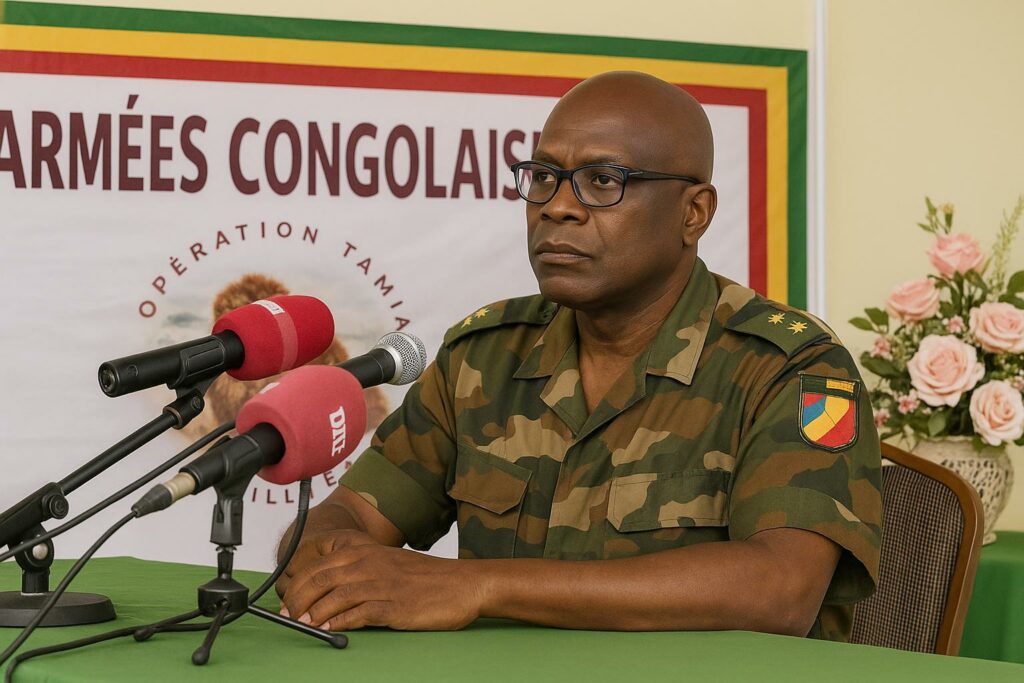Strategic Drill Rooted in Modern Threats
At daybreak on 22 August, the parade ground of the Académie militaire Marien-Ngouabi reverberated with martial cadences as Lieutenant-General Guy Blanchard Okoï formally activated Opération Tambo, the sixth iteration of the Manœuvre École, or Maneco-6. Designed as a command-post exercise, the drill places senior staff trainees and future unit commanders inside a scenario where a mixed task force must reclaim and pacify a volatile border corridor riddled with trafficking and non-state armed groups. The fictitious plot mirrors genuine security externalities that persist along several central-African frontiers, thus granting the exercise immediate operational relevance, defence officials explained in Brazzaville-based newspaper Les Dépêches (Les Dépêches de Brazzaville, 23 August).
While earlier editions of Maneco emphasised conventional manoeuvre, the present cycle accentuates multidimensional conflict. Cyber intrusion, illicit financial flows and cross-border disinformation are woven into the training software so that cadets digest the complexity of today’s theatres. “The emergence of new routes of war calls for a decidedly multidimensional answer,” General Okoï told assembled officers, insisting that the Republic of the Congo’s armed forces must anticipate “protéiforme” threats while remaining anchored in classic soldiering values.
Interagency Synergy at the Core
Beyond the army’s land component, Maneco-6 synchronises air assets, riverine patrol units, gendarmes, customs inspectors and forestry rangers. Colonel-Major Jean-Pierre Bouka, who heads the military schools command, underlined that success now depends on seamless information flows among ministries and uniformed corps. In practical terms, joint cells equipped with newly upgraded encrypted radios and satellite links exchange real-time terrain graphics to accelerate the decision loop.
Observers from the Economic Community of Central African States were invited to monitor the exercise, a gesture that highlights Brazzaville’s intent to share best practices without compromising sovereignty. Defence analysts at the Institute for Security Studies in Pretoria note that such inclusive outreach tends to deter misperceptions among neighbouring capitals and can pave the way for crisis-response mechanisms that pre-empt escalation.
Pedagogical Innovation and Career Metrics
Opération Tambo is more than a curricular waypoint; it functions as a pre-appointment assessment for the 29th promotion of active-duty officer cadets and for candidates of the inter-service staff course. Performance metrics cover not only tactical acumen but also resilience under cognitive stress, a factor that contemporary military psychology links to mission endurance. Successful participants may fast-track into battalion-level commands or staff billets within joint headquarters—a policy aligned with President Denis Sassou Nguesso’s 2022–2026 Defence Sector Guidance Document, which emphasises meritocratic advancement.
The simulation software feeding the exercise was developed in partnership with Congolese engineers trained in France and India, an illustration of the administration’s long-standing commitment to bilateral capacity-building. According to the Ministry of Higher Education, elements of the code will be migrated to a civilian crisis-management platform later this year, further blurring the once rigid line between national defence and civil protection.
Regional Stability and Diplomatic Significance
From a diplomatic perspective, Opération Tambo underscores Brazzaville’s determination to contribute constructively to sub-regional peace. The fictive enemy force in the scenario benefits from clandestine support emanating from a neighbouring territory, a narrative choice that gently reminds regional actors of their shared responsibility to curb sanctuary dynamics without naming or shaming any state. A senior official at Congo’s Ministry of Foreign Affairs argued that the exercise illustrates “our preference for collective security arrangements grounded in dialogue, yet backed by credible force when required.”
International partners have taken note. France maintains a long-standing defence accord with Congo, and its liaison officers attended the opening ceremony. Meanwhile, China’s People’s Liberation Army dispatched two observers specialised in logistics. Both nations quietly welcome the emphasis on interoperability, perceiving it as a guarantee that humanitarian corridors and extractive infrastructures—oil terminals at Pointe-Noire or timber routes in Sangha—remain insulated from insurgent spill-overs.
Balancing Sovereignty and International Partnerships
While the Republic of the Congo has prudently diversified its security partnerships, officials are emphatic that decision-making retains a sovereign anchor. The data architectures showcased during Maneco-6 run on servers located in Brazzaville and Oyo, subjected to Congolese cyber legislation enacted last year. In a commentary carried by public broadcaster Télé-Congo, cyber-jurist Julienne Okemba praised the approach as “a calibrated opening to global know-how without surrendering critical national data.”
Ultimately, Opération Tambo offers more than a spectacle of armoured columns on red-laterite tracks; it is a laboratory where officers internalise a doctrine that blends classic territorial defence with the softer skills of negotiation, intelligence fusion and community engagement. By compressing ten days of accelerated dilemmas into the minds of its brightest cadets, Congo positions itself to navigate a security environment that is at once volatile and replete with opportunity. In the measured words of General Okoï, “our past successes have rested on synergy of effort, shared learning and unwavering commitment; our future will demand nothing less.”

